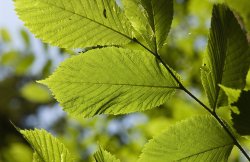An epidemic of Dutch elm disease in Scotland and north-west England
Dutch elm disease is one of the most serious tree diseases in the world. Bark beetles spread the fungus that causes the disease, which triggers foliage and tip dieback in all of Britain’s major native elms: English elm (Ulmus procera), smooth-leaved elm (U. carpinifolia or U. minor) and wych elm (U. glabra).
The disease first spread to Britain in the 1920s when it killed 10-40% of elm trees. Although the initial epidemic died down, a more aggressive species of the Dutch elm disease fungus, Ophiostoma novo-ulmi, was accidentally introduced into Britain in the 1960s.
An epidemic rapidly took hold of lowland central and southern Britain in the 1970s. However, the progress of the epidemic was much slower on the predominantly wych elm (U. glabra) populations of Scotland and North-West England. This slower progress means that many mature elms can still be found in these areas.
At least three likely causes of this slower disease progression are apparent:
- U. glabra does not sucker like U. procera or U. carpinifolia, so it suffers less from disease transmission via root grafts
 .
.
Pictured: Wych elm foliage.
- Although U. glabra is considered even more susceptible to O. novo-ulmi than U. procera, it is much less favoured by the bark beetles for feeding.
- The fungus Phomopsis, which is a common, rapid invader of the bark of newly dying wych elm, acts as a competitor of the elm bark beetles which normally breed in the bark. Phomopsis appears to exert a natural biological control of the beetle populations of the north and west.
In addition, climatic constraints probably reduce the disease activity of the pathogen by producing fewer opportunities for beetle-originated infections in the summer. The climate might also restrict the size and number of annual bark beetle generations compared with southern Britain or continental Europe. Such factors have aided a disease management campaign in Edinburgh city.
Nevertheless, the disease is still active in Scotland and it has moved into U. glabra populations that were not affected by the first epidemic. The disease is also continuing to push northwards, particularly on the east coast north of Aberdeen. This northwards expansion probably reflects the fact that O. novo-ulmi has a lower optimum temperature for growth than O. ulmi, and the much greater epidemic momentum that O. novo-ulmi has generated, allowing the larger elm bark beetle, Scolytus scolytus, to expand beyond its previous northern territorial limits.
The disease is now well established in an area around the north and east of Inverness, including the Black Isle. It should be pointed out that this area has an appreciably higher average temperature than is common in this part of Scotland, and that significant disease losses there do not mean that the whole region is equally vulnerable.
Find out more about the history of Dutch Elm disease in Britain.
